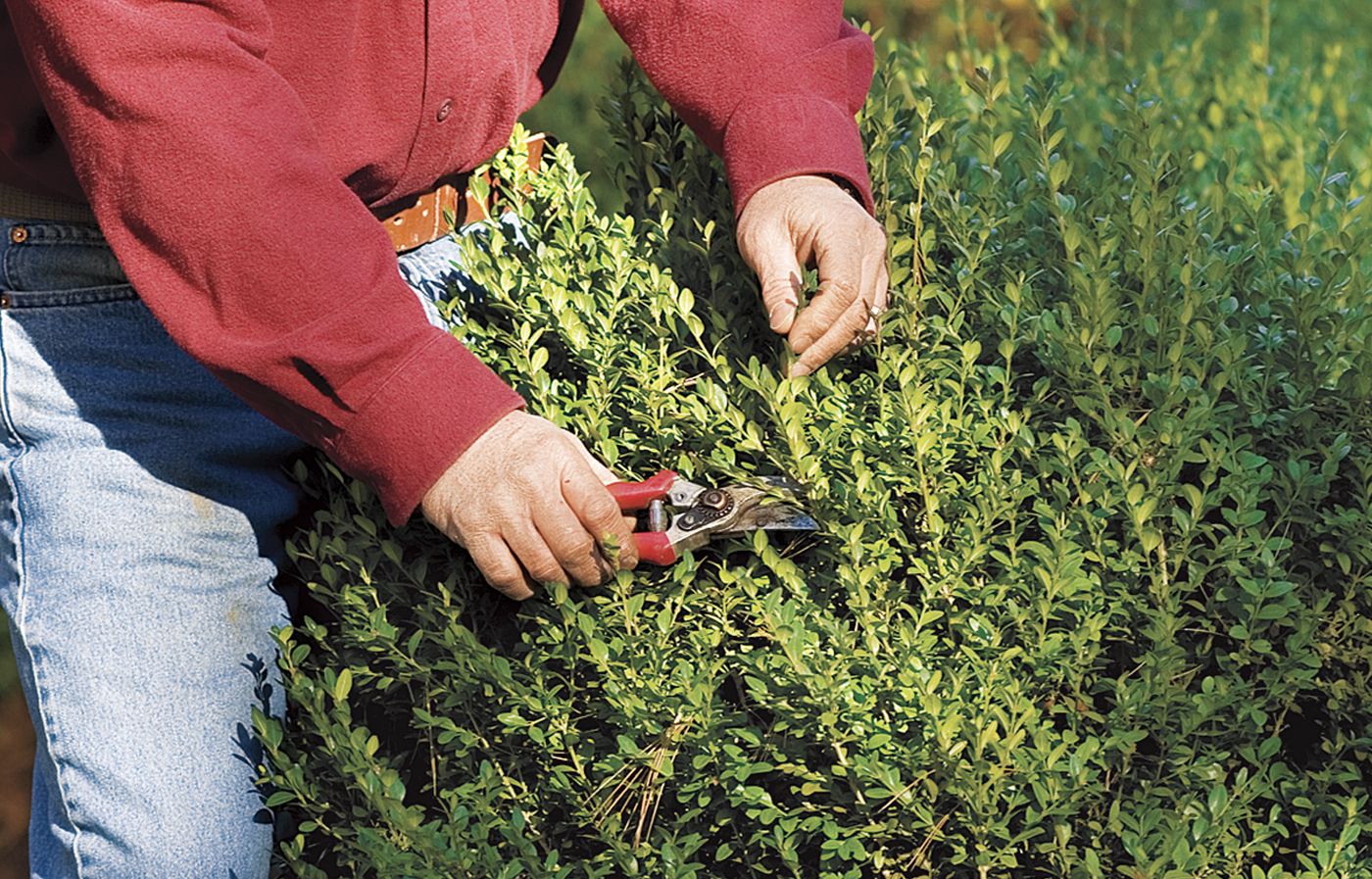Proper pruning is necessary for maintaining your shrubs’ health, shape, and vigor. The key to successful pruning is understanding how plants respond to cuts and knowing when to make them. Timing is important, as different shrubs have varying pruning requirements based on their flowering habits.
Snip Shape
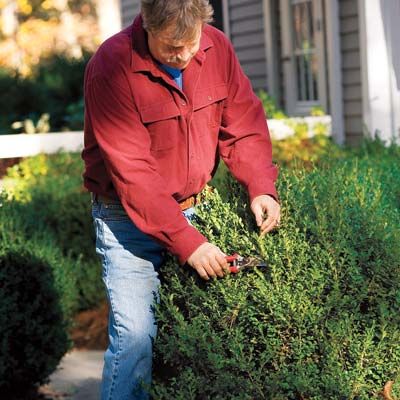
Mastering two basic pruning cuts—thinning and heading—is important for addressing common shrub problems. Thinning involves removing entire branches to open up the plant, allowing light and air to penetrate. On the other hand, heading involves cutting back a branch to just above a bud, encouraging branching at that point. The following sections will explore how to use these techniques effectively.
As horticulturalist Lee Reich explains, “Pruning distributes the plant’s stored energy among fewer flower buds so that the ones left behind get more to eat.” Shrubs that flower on new wood, such as rose-of-Sharon and summersweet, should be pruned in late winter or early spring—this pruning strategy results in fewer but larger flowers in the first year.
For spring-flowering shrubs that bloom on old wood or last season’s growth, it’s best to prune right after they finish blooming. This approach gives them the rest of the growing season to develop new branches and buds for the following year’s flowers. This Old House landscape contractor Roger Cook advises, “But if you miss the ideal time to prune, you can always wait until the shrub’s flowers brown out.”
Pro Tip: “To deal with a wayward evergreen branch, cut it back to the shrub’s center, where it meets another stem. If you just lop off the offending section, the cut stub will be obvious and unsightly. ” —Roger Cook, TOH landscape contractor
Fixing a Sloppily-Chopped Shrub
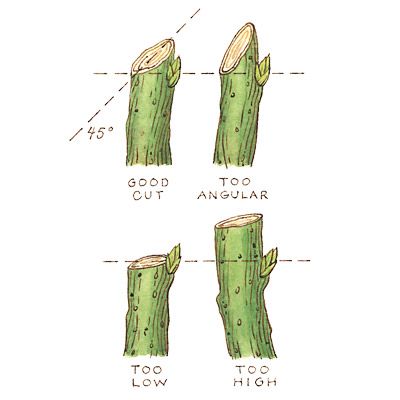
If you encounter a shrub with messy cuts, make selective cuts to neaten the shrub. This can stimulate new growth where desired and remove injured or less vigorous wood. Use sharp, clean tools and make cuts at the correct angle and location for quicker healing. Find a branch with a bud facing the direction you want new growth to follow. Prune just above that bud at a 45-degree angle, with the lowest point of the cut farthest from the bud.
Don’t leave more than 1/4-inch of growth above the bud, as this can encourage rot. Avoid cutting too low, as this can cause the bud to dry out. Also, refrain from cutting at an angle greater than 45 degrees, as this creates a large surface area that’s slow to heal and invites disease.
Patience is key when rejuvenating a poorly pruned shrub. It may take a few growing seasons to fully restore its shape and vigor, but consistent pruning will yield impressive results over time. Regularly monitoring the plant’s recovery and maintaining healthy practices will promote its successful revival.
Pruning Dense Foliage With a Sparse Interior
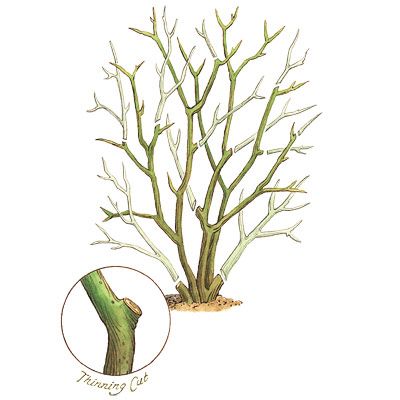
For shrubs that look “empty” in the middle, open up the plant with thinning cuts. This pruning method removes whole branches down to the base or takes off large sections of branches back to a main stem. Thinning allows light and air to reach the center of the plant, encouraging healthy new growth throughout. Remove the thickest, oldest wood before moving on to younger stems.
Don’t remove over one-third of a plant’s mass annually. Overpruning can stress the shrub and hinder its ability to recover. Instead, spread major pruning over several seasons to maintain the plant’s vigor and appearance.
Remember that simply trimming branch tips with manual pruners or electric shears often exacerbates the problem, resulting in dense foliage at the top and weak, leafless branches at the center. Proper thinning cuts are necessary for maintaining a healthy, well-balanced shrub.
In addition to thinning, make sure the shrub receives adequate water, nutrients, and sunlight to support new growth. This comprehensive approach will prevent the center from becoming bare again.
Evening Out a Lopsided Shrub by Pruning
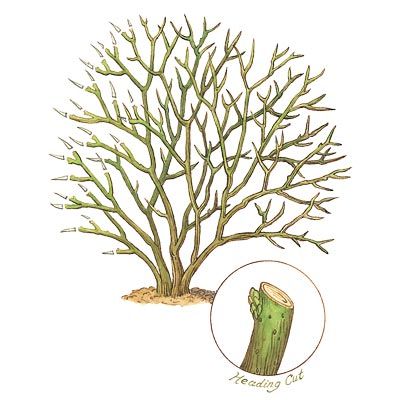
Use heading cuts to spur growth in the right direction. Unlike thinning cuts, heading cuts shorten a branch to a bud you want to encourage to branch out. Counter-intuitively, you need to prune the shorter side of a lopsided shrub to stimulate growth and even it out. Position the pruner on the part of the stem you want to remove, just above a bud that will grow in the direction you want to encourage.
Do not remove more than one-quarter of a stem’s length in any single cut. Combine thinning cuts to remove older wood from the longer side with heading cuts on the shorter side for dramatically lopsided shrubs.
Patience and consistency are important when addressing a lopsided shrub. It may take several growing seasons to fully correct the imbalance, but regular, targeted pruning will gradually restore symmetry to your shrub.
In addition to pruning, consider providing structural support, such as stakes, to help guide growth in the desired direction. This can be particularly useful for younger shrubs.
Patience Is Key for Pruning Woody, Tangled Shrubs
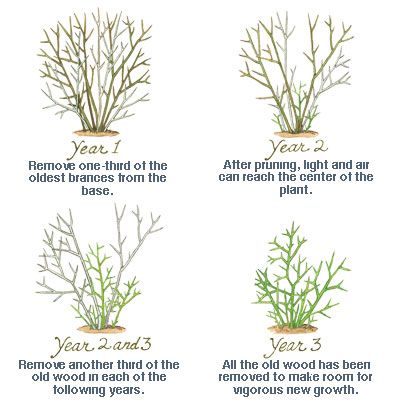
If your shrub looks like a tangled mess, give the plant an overhaul by thinning out the old wood over three years, which will provide room for all new growth. Start at the base of the shrub and eliminate the centermost branches, taking out no more than one-third of the shrub’s total mass. New growth from the base should follow the next growing season. Remove another third of the old wood at the base in years two and three. By the end of year three, the shrub should be composed entirely of new, vigorous growth.
Take care not to remove more than one-third of the shrub’s branches at any one time. This preserves enough foliage for the plant to produce sufficient food through photosynthesis, allowing it to stay robust and generate new growth quickly.
This gradual approach to rejuvenation pruning allows the shrub to maintain its overall structure while encouraging fresh, healthy growth. It’s an effective way to breathe new life into old, neglected shrubs without risking their health or survival.
In addition, apply mulch around the shrub base to retain moisture and support new growth. Regular watering and proper nutrition during this rejuvenation phase will also be necessary.
Dealing with a Leggy Shrub
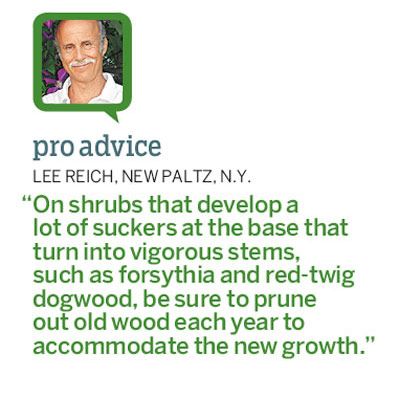
For leggy, flowering evergreen shrubs, use your index finger and thumb to pinch off the end (or terminal) buds of new branches on broad-leaved evergreens. This will encourage side branching on the lower part of the shrub. This manual removal of the terminal leaf bud signals a dormant bud below it to grow, stimulating lush side branching. This technique is also an effective way to control the shrub’s overall size.
Do not pinch off the flower buds in the process. These are typically the more prominent, fatter buds at the ends of branches. Accidentally removing flower buds will reduce blooming for the upcoming season.
When pinching, it’s important to be selective and patient. Focus on areas where you want to encourage fuller growth, and remember that it may take an entire growing season to see significant results. Regular pinching, proper fertilization, and watering can help maintain a fuller, more attractive evergreen shrub.
Additionally, consider lightly trimming the top growth to rebalance the shrub’s energy and promote healthier lower growth. This combined approach will help your evergreen shrub remain vibrant from top to bottom.
Our Conclusion
Proper shrub pruning is a valuable skill that can significantly enhance the health and appearance of your landscape. You can confidently maintain your plants by understanding the right techniques, timing, and approaches for different shrub types and problems. Remember to be patient—successful pruning often requires time and consistent effort. Regular care and attention to detail will lead to a thriving, beautiful landscape that you can take pride in all year round.
